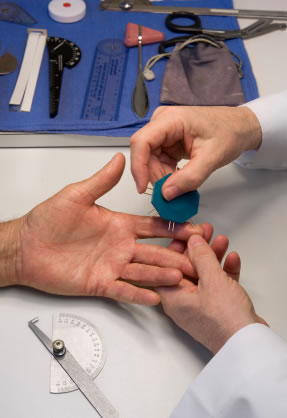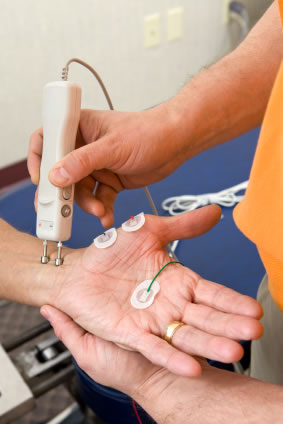Carpel Tunnel Syndrome (CTS) is an illness that first manifests its symptoms as a minor pain in the wrist and eventually works its way up to the hands. With the use of computers and typing skills becoming more routine in everyday events, the risk for CTS is much higher than it was ten years ago. According to many studies, women are more susceptible to Carpel Tunnel Syndrome than men. CTS is known by many other names such as Occupational Neuritis, Writer’s Cramp, Median Neuritis and Partial Thenar Atrophy.

Causes of CTS
There are several different causes of this annoying condition. Knowing the causes will help in the prevention of CTS. First of all, it’s important to know the definitions of the words Carpel Tunnel and Median Nerve.
Carpel Tunnel: A tunnel in the wrist that is formed by bones and tissues. The Carpel Tunnel protects the Median Nerve.
Median Nerve: This is the nerve that connects the thumb and the first three fingers on the hand. It helps with movement and feeling on those fingers.
A combination of conditions give birth to CTS because they put pressure on the Median Nerve as it passes through the Carpel Tunnel of the wrist: hence the name Carpel Tunnel Syndrome. The constant pressure causes parts of the hand to go numb, and as a result, the hand gets weak and sometimes hurts. Basically, any activities that decrease the space in the Carpel Tunnel, or increases the use of the Median Nerve will eventually lead to CTS.
Carpal Tunnel Syndrome? Get Remedies Fast!
Here is a list of different factors that can cause Carpel Tunnel Syndrome.
- Conditions such as Rheumatoid Arthritis, Gout, Diabetes, and Obesity can cause CTS because of the swelling in the joints and reduced blood flow that are brought on by these diseases.
- Continuous movements of the hand and wrist are another cause of CTS as they cause surrounding tendons to swell.
- Any previous broken bones can leave spurs that make their home in the Carpel Tunnel and will eventually put pressure on the Median Nerve.
- Any fluid build-up can cause pressure to be put on the Median Nerve will lead to CTS. This can occur from pregnancy, or as mentioned above, diabetes and arthritis
- Any work that involves forced and repeated hand movements, vibrations in the arm, or long periods of work in an awkward position can lead to CTS..
- Smoking can reduce the blood flow to the Median Nerve and contribute to CTS.
Symptoms
These are several early warning signs fo Carpel Tunnel Syndrome. These early signs will quickly become worse if they are not treated in a timely manner. The symptoms include:
- Tingling and numbness in the hands; in every finger except the little one. This often occurs while holding a phone, gripping a steering wheel, or after sleeping. During the early stages these symptoms will not last more than a few minutes at a time, but the condition will grow with time.
- Intense pain that radiates from the wrist and all the way up and down the arm, especially after long use. This normally occurs on the palm side of the forearm.
- Spasms when the hand goes weak and causes a person to randomly drop items.
Keep in mind that not all pains and/or numbness in the forearms and wrist are due to CTS. It is advised to seek the expertise of a physician if there is a problem as CTS can cause nerve damage if it’s not treated in a timely manner.
Risk Factors
Carpel Tunnel Syndrome comes from the overuse and strain due to certain jobs that require awkward and repetitive use of the hands. Below are several types of risk factors for CTS.
- Using power tools such as grinders, chain saws, or jackhammers can lead to CTS symptoms.
- Working on an assembly line such as a manufacturing plant is another repetative strain on the hands. As a result, it can lead to CTS.
- Smoking, as mentioned above, is a risk factor that can cause CTS to occur.
- Routinely driving long distances because the longevity of gripping the steering wheel.
- Women are three-times more likely to develop CTS than men.
There are many other factors that will put certain people at high risk of CTS. But far too many exist to list every single one; however, the warning signs are numbness in the hands and/or sharp pains through the forearm that shoot all the way to the shoulder.
When to Contact a Doctor
Home remedies can be used to treat mild symptoms of hand and wrist numbness or pain. More on Home Remedies are discussed later. However, if the symptoms are severe then a trip to the doctor is required. Remember that CTS can lead to permanent nerve damage if not treated.
Several early warning signs exist that will require a doctor’s visit. Do not hesitate to call a doctor if symptoms like the ones listed below are displayed.
- If the minor symptoms have not gone away after 2 weeks of treatments.
- Numbness in the fingers that have gradually built up over time.
- Accidentally start dropping things because of spasms in the hand.
- If the pinch between the index finger and thumb is very weak.
- Pain in the fingers and hand gets worse.
Exams
The first thing a doctor will do is review all of the symptoms to try and determine if Carpel Tunnels Syndrome is a factor. One clue is that CTS doesn’t cause anything to happen to the little finger, so if that finger is part of the problem then CTS is not a factor. Timing of the symptoms is another clue. For example, the optimal times that people experience CTS are while they are holding a phone or newspaper; or even while driving down the road gripping the steering wheel.
Once a doctor establishes that CTS is most likely the problem, they will perform the following tests in order to verify it.
- Electromyogram , ; This test measures electrical discharges in muscles and is mainly used to determine if there is any muscle damage.
- Nerve Condition Study , ; An electric signal is sent along the Median Nerve to test whether it slows when it travels through the Carpel Tunnel.
- X-Rays , ; This is to test for previous bone breaks or other factors that can contribute to CTS.
- MRI , ; Used to find swelling in the Median Nerve.
- Blood Tests- These can be used to diagnose other medical conditions that can cause CTS.
Treatments
There are a number of treatments for Carpel Tunnels Syndrome. These can be broke down into three categories: Home Remedies, Non-Surgical, and Surgical. The seriousness of the condition determines which path to follow.
Home Remedies
If the symptoms are in their initial stages and are still mild, home remedies can be used before going to the doctor. However, it’s important to note that if the symptoms get severe or do not go away within two weeks, then it is imperative to contact a trained physician because permanent nerve damage can occur from Carpel Tunnels Syndrome.

Home remedies usually involve over the counter medicines such as aspirin to relieve the symptoms. Also, wearing a wrist splint can help reduce the motion in the wrist and can sometimes allow the Median Nerve to heal by reducing swelling. Here are some other home remedies that can be used.
- Ice the wrist 15 minutes everyday. This can reduce swelling through the Carpel Tunnel.
- Immediately stop any activities that are responsible for the symptoms.
Non-surgical Treatments
If the symptoms are not too severe, the doctor will at first recommend non-surgical treatments to see if the symptoms improve. This may include:
- The doctor will look at the patient’s medical history to see if any other medical conditions are responsible for CTS. If so, then they will change the treatment for those particular conditions to see if that helps relieve the CTS symptoms.
- Non-Steroidal Anti-Inflammatory drugs may be used to reduce the inflammation of the Carpel Tunnel and the Median Nerve.
- Steroids may be injected into the Carpel Tunnel to reduce inflammation if the previous attempts are not successful.
Surgical Treatments
The majority of individuals with Carpel Tunnel Syndrome are treated without surgery. Only a small minority require surgery to relieve the symptoms. However, surgery will be considered if:
- There is an apparent sign of nerve damage.
- Non-surgical treatments do not work after a year.
- Symptoms become so severe that daily activities cannot be performed.
Surgery is used to release the pressure on the Median Nerve and is done by cutting ligaments that form the top of the tunnel. Any tumors or such that is causing pressure to the Median Nerve will also be removed during surgery.
The two Carpel Tunnel Release Surgeries are Open and Endoscopic.
- Open Carpel Tunnel Release Surgery , ; Requires an incision from the palm of the hand to the wrist. This type of surgery allows the doctor to see more of the inner workings. Since this is a rather sizeable incision, it requires more recovery time.
- Endoscopic Carpel Tunnel Release Surgery , ; This type doesn’t require a large incision, only a the wrist and palm. A camera is used to allow the surgeon to see inside of the Carpel Tunnel and relieve the pressure on the Median Nerve. Since the incision is small, the recovery time is minimal.
Alternative Treatments
Many time-honored treatments exist for a number of conditions and CTS is no different. Some use yoga as a way of relaxing and helping cope with pain that comes from some muscle conditions. Since yoga encourages strength, stretching, and balance, it is a great alternative method for preventing CTS.
Some take daily vitamins to help prevent any abnormal conditions from occurring. B-6 is a great supplement for preventing and even relieving symptoms of CTS.
Tips for preventing carpel tunnel syndrome
The easiest for if treatment for any condition is preventing it in the first place. As with anything else, there are several steps that can be followed that will help prevent Carpel Tunnel Syndrome.
- Relax the hand’s grip on objects. People tend to use way more force than what’s necessary to perform many actions.
- Give the hands and wrist frequent breaks from extended work.
- Practice bending the wrist properly instead of all the way up or down.
- Posture can have a major impact on the nerves in the neck. Practice good posture.
- Hands that are cold are more likely to become stiff and form pain. Keep them warm at all times.
- Lower salt intake as it can cause the body to retain more water; remember that fluids are a cause of CTS.
- Stop smoking.

No Comments